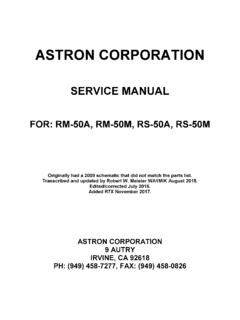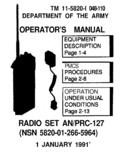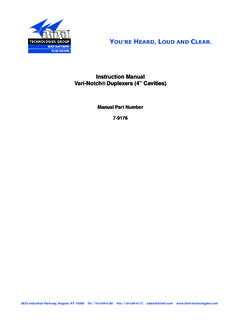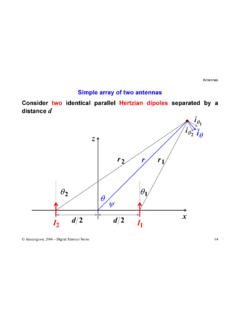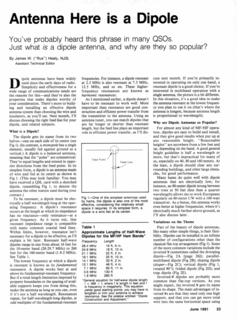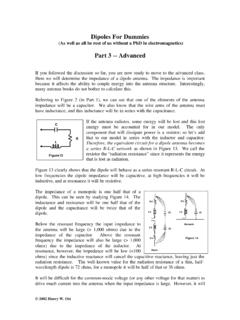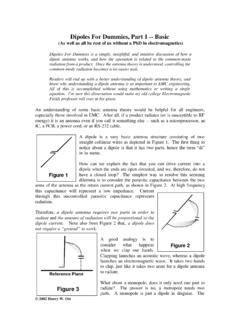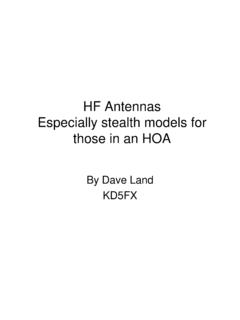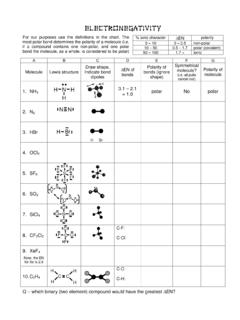Transcription of Homebrew Coaxial Dipole for VHF or UHF - Repeater Builder
1 July 2009 1 Hams like to build antennas, espe-cially if they re made from ordinary hardware store items and can be assembled with common hand tools. Here is a Homebrew Coaxial Dipole built from a small stainless whip, a length of threaded table-lamp tubing and some 3 4 inch cop-per and PVC fittings. The one shown is for 440 MHz but it can readily be scaled for 146 or 220 Homebrew vertical VHF antennas, Coaxial dipoles often play second fiddle to J-poles. That s because the center connec-tion to coax is often difficult to fabricate in the home workshop. Yet both antennas have the same performance. They re both full sized, half wave vertical dipoles, and the Coaxial is a Coaxial DipoleIf you start with a common half wave ( /2) stainless whip and extend it all the way down through a /2 long support tubing, Homebrew Coaxial Dipole for VHF or UHFHere s a base station antenna you can easily build for 146, 220 or 440 MHz.
2 Performance is equal to a J-pole, but it s smaller, less obtrusive and more E. Portune, W6 NBChere made from a threaded table lamp tube, the lower part of the whip becomes the cen-ter conductor of a short length of rigid coax feeding the center of the antenna. Now con-nection to normal coax is easily made below the antenna. To form the rigid coax section, you ll need to insulate the center conductor (lower part of the stainless whip) from the lamp tubing with some 1 4 inch inside diam-eter (ID) polyethylene tubing. Hardware stores normally carry it. This short length of rigid coax formed in this way isn t precisely 50 characteristic impedance, but the dif-ference is totally insignificant. The drawing in Figure 1 shows the DetailsThe bottom half ( /4) of the radiating Dipole is a Coaxial sleeve made from 3 4 inch copper pipe and a pipe cap. The coax feed runs up its center to the connector at the bottom of the lamp tubing.
3 Support and insulation of the bottom of the sleeve is pro-vided by a 3 4 inch CPVC plastic pipe cap. For those not familiar with CPVC fittings, they re made to mate with copper pipe and can handle high water temperatures. That s not true of common PVC fittings. Most hardware stores now carry CPVC. Drill a 3 8 inch hole in the center top of the copper and the CPVC caps for the lamp tubing to pass whole antenna is held together by two lamp tubing nuts and a plastic lamp fin-ial, also readily available at hardware stores (see Figure 2). Note that a lamp tubing nut is also required inside the copper pipe cap. Drill a small hole in the middle of the lamp finial for the stainless whip. On the bottom of lamp tubing below the antenna install a 11 4 inch common PVC pipe cap, and secure it with two more lamp tubing nuts. This gives you a way to easily mount the antenna on top of any convenient length of 11 4 inch Figure 1 Dimensioned drawing of Coaxial Dipole for three July 2009 Did you enjoy this article?
4 Cast your vote at: .htmlFigure 2 Details of final assembly of Coaxial pipe. Run the coax feed down through the PVC pipe. Hooking it UpA conventional PL-259 UHF type coax connector for RG-8 coax will actually screw onto the bottom of the lamp tubing. The threads are not a perfect fit, but will tighten satisfactorily. The stainless whip runs down all the way to the very tip of the PL-259 con-nector. Solder it in there. Before doing so, however, install all the pieces of the antenna onto the threaded lamp hams may think that stainless steel won t solder. It definitely will with a hot iron and acid flux. Scrape the end of the whip and dip it in hydrochloric swimming pool acid. With a little action from the tip of the soldering iron the whip will tin perfectly well. Before soldering, however, grind two or three small side notches in the bottom end of the whip. A Dremel tool works well for this.
5 The notches will help the solder securely lock the whip into the tip of the PL-259 connector. Neutralize any leftover acid with baking soda surprising to some, it really isn t necessary to solder any other parts of the antenna. There is adequate mating surface at the joints for the RF to cross over efficiently. Do, however, seal all possible water access spots with common silicone RTV glue and or plastic electrical it for the Band You LikeThere isn t an exact length required for the lamp tubing or the stainless whip. These size, less obtrusive appearance and superior weatherproofing as compared to a J-pole. ARRL Member John Portune, W6 NBC, received a BSc in physics from Oregon State University in 1960, his General Radiotele-phone license in 1961 and his Advanced class amateur license in 1965. He spent five years in England as G5 AJH and upgraded to Amateur Extra class in 1985 to become a volunteer examiner (VE).
6 John retired as a broadcast television engineer and technical instructor at KNBC in Burbank and then from Sony Electronics in San Jose, is active on many bands and modes, predominantly from his HF RV mobile station. He has written various articles in ham radio and popular electronics magazines and remains active as a VE team leader, ham license teacher and Web site designer. You can reach John at 1095 W McCoy Ln #99, Santa Maria, CA 93455, or at merely need to provide enough space for all the pieces of the antenna to go together. I had a 48 inch whip on hand that I used uncut for my 146 MHz Coaxial Dipole and a similar 17 inch uncut whip for 440 MHz. I merely cut the lamp tubing to an appropri-ate length to fit the whips. What does matter, however, is the length of the whip above the top of the lamp tubing as well as the length of the Coaxial sleeve. These need to be close to a /4. For 440 I used 61 2 inches, on 220, 13 inches, and 19 inches for 146 MHz.
7 These antennas are quite broad band and will cover the entire band in each case with these sizes. No cutting or pruning is ruggedness, or perhaps for stealth, you can install the whole antenna inside of 2 inch PVC water or ABS soil pipe and close the ends with end caps. I live in a mobile home park where antennas are not permitted, but my landlord thinks my Coaxial dipoles (in ABS pipe) are vent out one of these Homebrew Coaxial dipoles. You may find you prefer its smaller


